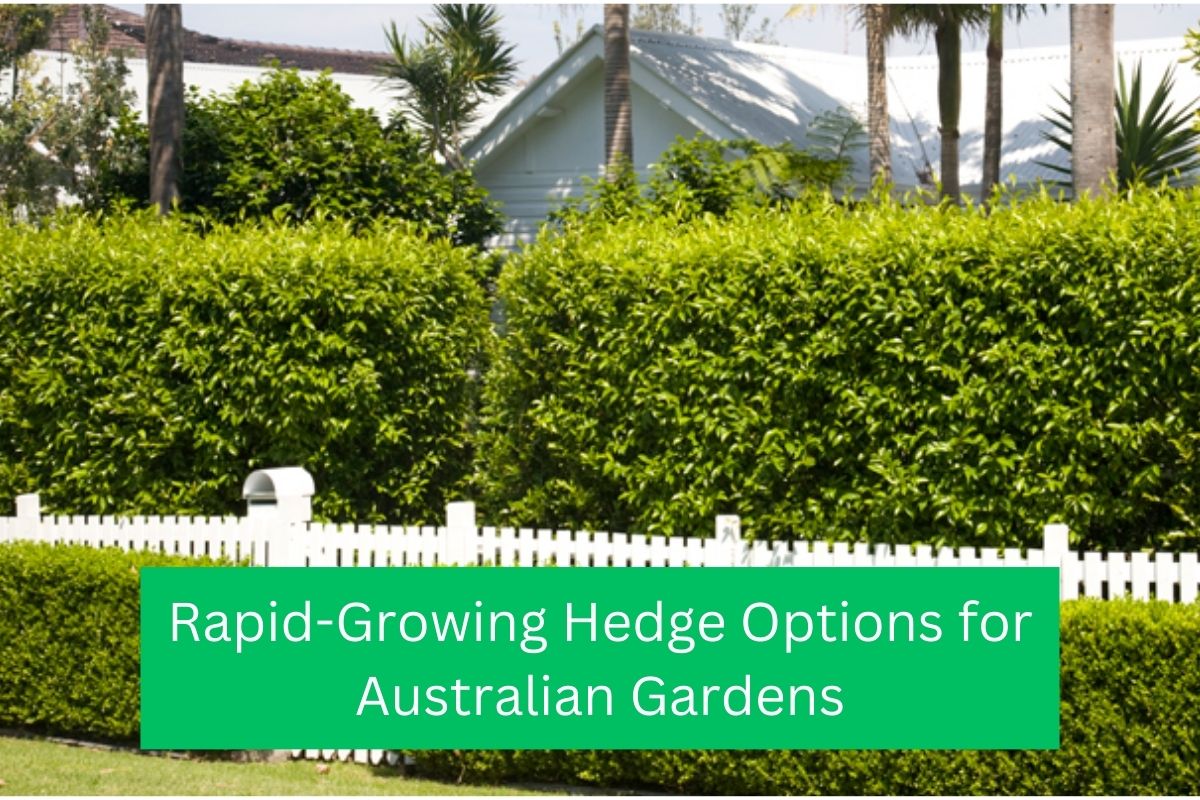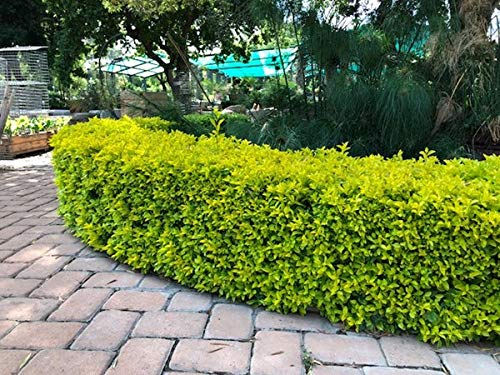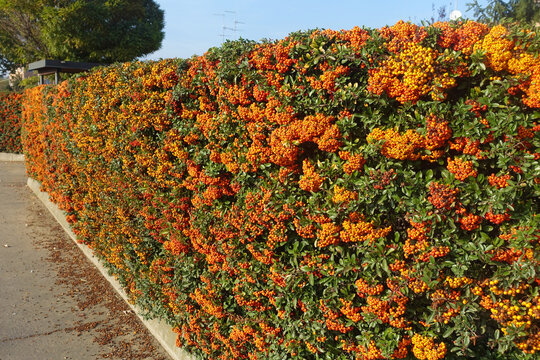
Rapid-Growing Hedge Options for Australian Gardens
Hedges are functional and can add a touch of elegance and privacy to your garden. When you’re looking for rapid growth, it’s essential to choose hedge plants that thrive in the Australian climate and soil conditions. Here, we’ll explore some excellent choices for fast-growing hedges well-suited to Australian gardens.
Top 10 Fast-Growing Hedges in Australia
- Lilly Pilly (Syzygium spp.)
- Bottlebrush (Callistemon spp.)
- Pittosporum (Pittosporum spp.)
- Acmena (Acmena spp.)
- Bamboo (Bambusa spp.)
- Duranta (Duranta spp.)
- Lavender (Lavandula spp.)
- Escallonia (Escallonia spp.)
- Photinia (Photinia spp.)
- Pyracantha (Pyracantha spp.)
Lilly Pilly (Syzygium spp.)
Syzygium australe, or the “Lilly Pilly,” is popular. It’s a native Australian plant with various cultivars that offer fast growth, vibrant foliage, and the benefit of attracting native birds.

Also Read This : Growing Aparajita from Cuttings and Seeds: A Step-by-Step Guide
Bottlebrush (Callistemon spp.)
The bottlebrush hedge is adorned with unique, brush-like flowers. Its rapid growth and hardiness make it a fantastic choice for Australian gardens.

Pittosporum (Pittosporum spp.)
Pittosporum hedges, such as Pittosporum tenuifolium, offer lush green foliage and proliferate to create a dense screen.

Acmena (Acmena spp.)
Acmena, often called the “Eugenia” or “Syzygium,” is a rapid grower that can be trimmed to form a formal hedge or left to grow more naturally.

Also Read This : No Sun, No Problem: Low-Light Plant Varieties
Bamboo (Bambusa spp.)
Clumping bamboo varieties like Bambusa textilis gracilis can be a fast-growing and exotic hedge option, creating a dense, green screen.

Duranta (Duranta spp.)
Duranta hedges, like Duranta repens, multiply and feature attractive, small blue flowers and vibrant, golden foliage.

Lavender (Lavandula spp.)
Lavender hedges, particularly Lavandula angustifolia, offer fragrant and rapid growth, adding beauty and functionality to your garden.

Escallonia (Escallonia spp.)
Escallonia hedges, such as Escallonia ‘Pink Princess’, grow swiftly and produce clusters of pink or white flowers.

Also Read This : 10 Ways Plants Enhance Your Yoga Practice
Photinia (Photinia spp.)
Like Photinia x fraseri, Photinia is known for its vibrant red foliage and rapid growth, making it a popular choice for hedges.

Pyracantha (Pyracantha spp.)
Pyracantha, also known as Firethorn, offers swift growth and vibrant berries and thorns that provide security.

Essential Considerations for Your Hedge Selection
When selecting a hedge for your garden, several essential considerations should guide your choice. These factors help ensure the hedge suits your needs and thrives in your specific environment:
Climate and Hardiness:
Choose a hedge that is well-suited to your local climate and hardiness zone. Consider factors like temperature extremes, rainfall, and seasonal variations.
Also Read This : 2 Method to Grow Ginger (Adrak) at Home
Sunlight Requirements:
Determine the amount of sunlight the planting area receives throughout the day. Some hedges thrive in full sun, while others prefer partial or complete shade.
Soil Quality and pH:
Assess the soil quality, drainage, and pH level in your garden. Certain hedges may have specific soil requirements for optimal growth.
Purpose of the Hedge:
Define the primary purpose of your hedge. Are you looking for privacy, windbreak, ornamental appeal, or a combination of these factors?
Growth Rate:
Consider the speed at which the hedge will grow. If you need a fast-growing hedge for immediate results, select a species known for rapid growth.
Also Read This : Growing Garlic in Your Home Garden: A Step-By-Step Guide
Maintenance Requirements:
Evaluate the amount of maintenance you’re willing to commit to. Some hedges need regular pruning and care, while others are low-maintenance.
Aesthetic Preferences:
Think about the visual appeal you desire. Hedges come in various colours, shapes, and flowering habits. Choose one that complements your garden’s aesthetics.
Local Regulations:
Be aware of any local regulations or restrictions on hedge height, type, or placement. These rules can vary by region and may influence your choice.
Wildlife Attraction:
Some hedges attract beneficial wildlife like birds and pollinators. Consider the potential ecological impact of your hedge.
Also Read This : What are the Best Ways to Revive a Dying Hibiscus?
Allergies and Toxicity:
If you or your family members have allergies, be cautious of hedges that release allergenic pollen. Additionally, be aware of any hedge species that may be toxic to pets or children.
Long-Term Planning:
Think about the long-term goals for your hedge. Some hedges require more time to establish, while others may need replacement after a certain lifespan.
Budget:
Consider your budget for hedge installation and maintenance. Some species may be more cost-effective than others.
Also Read This : Protect Your Pooch: A Comprehensive Guide to Poisonous Plants for Dogs
Choosing the Right Spot for Your Hedge in Australia
Selecting the right spot for your hedge in Australia is crucial in ensuring its success and longevity. Here are some key considerations when choosing the location for your hedge:
Sunlight Exposure:
Most hedges thrive in full sun or partial shade. Assess the sunlight exposure in your garden to determine if the chosen spot receives adequate sunlight throughout the day. Some native Australian hedges, like Lilly Pilly, are versatile and can tolerate different light conditions.
Soil Quality and Drainage:
Examine the soil quality and drainage in the chosen area. Well-draining soil is essential to prevent root rot and other moisture-related issues. If the soil is heavy clay, consider amending it to improve drainage.
Also Read This : How to Propagate Roses Using Potato Cuttings
Space Availability:
Ensure enough space for the hedge to grow to its mature size without overcrowding or encroaching on neighbouring plants or structures. Plan for both the width and height of the hedge.
Purpose of the Hedge:
Identify the primary purpose of your hedge, whether it’s for privacy, windbreak, ornamental beauty, or a combination of these. The purpose will influence the height and density required.
Wind Exposure:
Consider the prevailing wind direction in your area. If your garden is exposed to strong winds, a windbreak hedge can provide shelter and protect your other plants.
Also Read This : Fascinating Plant Fun Facts
Local Regulations:
Check local regulations regarding hedge placement, height restrictions, and potential permits required. Regulations can vary by region, and compliance is essential.
Aesthetics and Garden Design:
Harmonize the hedge with your garden design and overall aesthetics. Choose a location that complements your landscape and enhances its visual appeal.
Existing Flora:
Be mindful of the existing plants and trees in the area. Avoid planting the hedge too close to established vegetation, as it can compete for resources.
Also Read This : Enhance Your Gardening with Grow Bags
Wildlife Considerations:
If you want to attract wildlife like birds and pollinators, consider the proximity of your hedge to other natural features, such as bird feeders, bird baths, and flowering plants.
Accessibility:
Ensure that the hedge is easily accessible for maintenance and care. Trimming and shaping your hedge will be more manageable if it’s not in a hard-to-reach spot.
Microclimates:
In some Australian regions, microclimates may affect your hedge’s success. For instance, coastal areas may have different climate conditions than inland locations.
Also Read This : Utilizing Grow Lights for Indoor Plant Cultivation
Caring for Your Hedges in Australia
Proper care and maintenance are essential to enjoy the full benefits of your fast-growing hedges in Australia. You will witness rapid growth, a healthier plant, and a more visually appealing landscape by ensuring your hedge receives the best care.
Fast-growing hedge species seem like a great, low-maintenance option due to their rapid growth and quick establishment. However, their speedy growth often requires more frequent maintenance than slower-growing plants.
Prune regularly
Prune regularly to keep your hedge looking its best. Pruning encourages denser growth, making the hedge thicker and more private while controlling its height and spread to prevent it from encroaching on your neighbour’s space or overtaking other plants in your garden. Having the right tools is essential for effective pruning without causing any damage. Hedge trimmers are the ideal tools to help you achieve precise and clean cuts, ensuring your hedge’s health and visual appeal. Whether working with a small or large hedge, the best hedge trimmers offer many features and options to meet your specific pruning requirements.
Also Read This : How to Prune Lavender: A Step-by-Step Guide
Remember, while these hedges offer rapid growth, proper care and maintenance are essential to achieve the desired results. Regular pruning, watering, and soil conditioning ensure your hedges flourish and provide the privacy and beauty you seek in your Australian garden. Before planting, consider your garden’s specific conditions, such as sunlight, soil type, and space, to select the ideal hedge for your needs.




